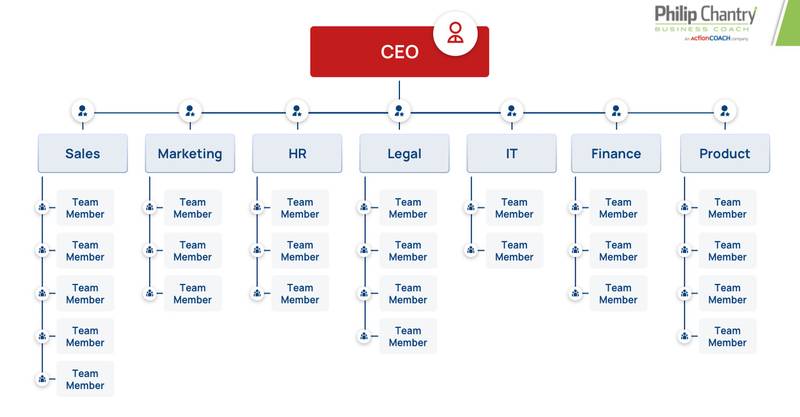What does your business structure look like? Do you group employees according to their function or do you mix together areas of expertise?
Your organisational structure’s likely to depend on your company’s size, culture, and specific business needs. But if you’re running a medium to large company in particular, a defined organisational structure helps you to manage employees and to achieve your business goals.
One of the most popular formats is a functional organisation structure. But what is it and would it work for your business? Read on to find out.

What is a Functional Organisational Structure Format?
If you’ve ever worked in a larger company, you’ll likely be familiar with this hierarchical structure.
The company’s divided into different departments or teams defined by their specialisation. There’s likely to be finance, sales, marketing, IT and human resources departments for example. Each of these departments is lead by a functional manager or department head who oversees their team’s work and performance.
It’s a fairly typical and structured chain of command. In each department, team members report to their department head, and they report to the company’s top management.
Take this functional structure example of a company organisational chart:

- CEO
- Senior management team (Functional department heads)
- Sales department
- Marketing department
- Human Resources department
- Legal department
- IT department
- Finance department
- Product or service department
Characteristics of a Functional Organisation Structure
There are a few main features of this type of organisation and its structure:
1. A top-down hierarchical structure: the senior management team call the shots and have decision-making authority for the whole company. Employees sit within specific, functional departments
2. Department heads report into senior management: each department head is either part of the senior management team or reports directly to them
3. Specialisation is key: people are hired for their particular skill sets and work in separate departments with team members who have similar skills or competencies
4. Work in silos: people tend to stay in their department, so information flows within their functional silos rather than communicating across other departments
5. Specific goals: each individual department has clearly defined team-based goals related to their specific function.
What are the Advantages of a Functional Structure?
Clarity and stability: clearly defined reporting structures and individual responsibilities. People understand the scope of their work and what’s expected of them.
Operational efficiency: as each department has very clear roles and team-based goals, there’s less chance of overlap with other departments. Similarly, problems in one functional department won’t have a huge knock-on effect on other departments.
High productivity: as employees have specialised skillsets and work within those areas, they tend to work more quickly, efficiently and to a higher standard than those less familiar with that specialism.
Predictability: stable, functional structures make it easier to manage long-term planning and day-to-day operations.
Skill development: employees develop a high level of expertise in their specific area and work within their area of strength.
Simplified training process: learning and development programs that are focused on specific functional areas can be designed and implemented efficiently.
What are the Disadvantages of a Functional Structure?
Isolated silos: with a firm focus on your own team and area of speciality, there’s less opportunity for collaboration and communication between departments
Limited viewpoint: team members are less likely to focus on the bigger picture and don’t see how their role contributes to the business’s overall goals and objectives, or even to other departments
Lack of innovation: bringing together varied perspectives and a range of knowledge and experiences can result in more creative thinking and dynamic ideas and initiatives. That doesn’t happen with this business structure
Cross department competition: there can be resentment between departments, especially if one seems to get more resources or attention than the other
Slow decision-making: when decision-making requires input and approval from multiple departments, it takes time
Career limitations: employees feel they have to stay in their lane. There’s less chance of diversifying and transferring skills to another area of speciality.
4 Types of Organisational Structure
Hierarchical Structure
There’s a direct top-down chain of command in the company. Think of it as a pyramid-style structure. There are multiple levels of authority with the CEO or highest level of leadership at the top, their senior management team below them and so it goes on. Each level has clear lines of responsibility and control.
Flat Structure
As opposed to a hierarchical structure which has many tiers, there are far less levels of management here. In fact, most levels of middle management are removed. There’s less separation between employees and senior management. Employees are given more responsibility and decision-making power. It encourages open communication and collaboration.
A flatarchy combines elements of both a hierarchical structure and a flat structure. That may involve gathering experts from different functional departments to provide input on a new product or service, for example.
Divisional Structure
A company is split into divisions according to their specific product, service or geographic area. This tends to be used by large companies, possibly global or those who own separate, smaller companies. A company like Disney or Apple would have their UK division, and that’s likely to be run fairly autonomously but with direct reporting lines into the US headquarters.
Matrix Structure
A matrix structure combines elements of the functional organisational structure with elements of the divisional structure. Think of the structure like a grid. Employees with similar skills are grouped together (such as a product development or marketing department) and they report to more than one manager.
This is often used for project management. Say a beauty company’s launching a new skincare product. They’ll bring together someone from the marketing department, the sales team and the product team to launch that product to market. In a start up or small business, that may just be one or two in each department. But it also works for larger companies working on specific projects.
What’s the Best Organisational Structure for Your Business?
- Functional organisation structure
- Hierarchical structure
- Flat structure
- Divisional structure
- Matrix structure
Which of these models struck a chord with you and could help to structure your business better?
Perhaps your company’s growing or merging with another? Maybe the way you’ve always run the business just isn’t cutting it anymore. Are you and your team members happy with the current set up?
I can help you to work through that change. I can help you to find a better way forward for you, your team and your business. I’ll set you on the path for success and will be there to keep you on the right track. Let’s have a chat today




